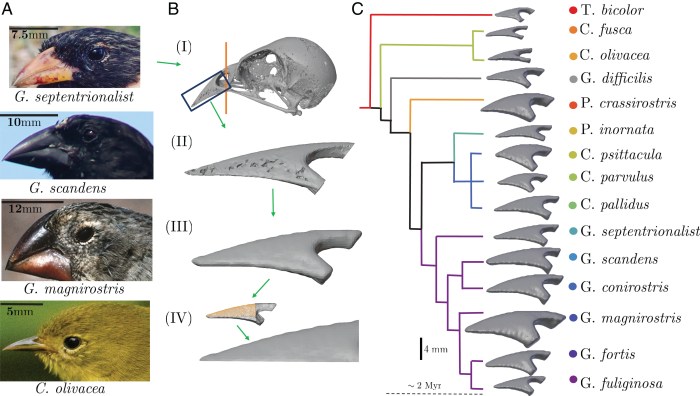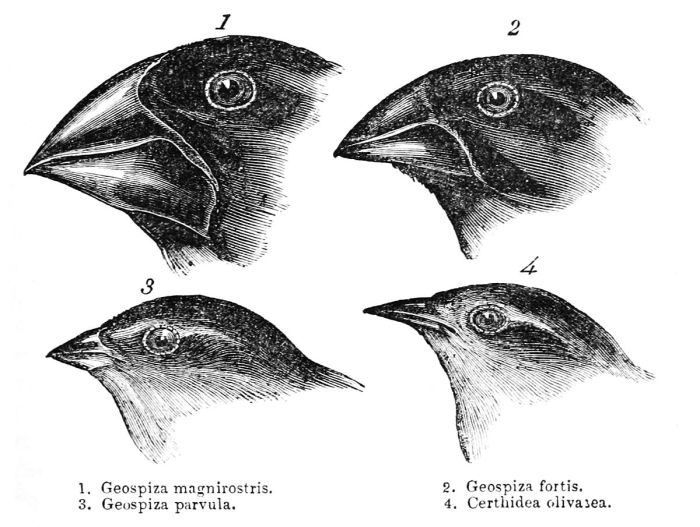Origin of species the beak of the finch answers – The origin of species, as exemplified by the beaks of finches, stands as a testament to the power of natural selection. Charles Darwin’s observations of these birds during his voyage on the HMS Beagle provided crucial evidence for his theory of evolution.
Finches’ beaks exhibit remarkable diversity, reflecting adaptations to specific environmental niches. The shape and size of their beaks determine their ability to access different food sources, contributing to their survival and reproductive success.
Evolutionary Adaptation of Finches’ Beaks

Natural selection is a fundamental evolutionary mechanism that drives the adaptation of species to their environments. In the case of finches, natural selection has shaped the beaks of these birds to suit the specific food sources available on different islands in the Galapagos archipelago.
Beaks that are better suited to extracting and consuming particular types of food provide a survival advantage, allowing finches with these traits to thrive and reproduce more successfully in their respective environments.
For example, ground finches on the island of Daphne Major have evolved beaks that are ideal for cracking open hard seeds. In contrast, tree finches on the island of Santa Cruz have beaks adapted for consuming insects and nectar from flowers.
These variations in beak morphology are a testament to the power of natural selection in driving the evolution of species.
Charles Darwin’s Observations and Theories, Origin of species the beak of the finch answers
Charles Darwin’s voyage on the HMS Beagle in the 1830s was pivotal in shaping his theory of evolution. During his visit to the Galapagos Islands, Darwin observed the remarkable diversity of finches across the archipelago. He noticed that different species of finches on different islands had distinct beak shapes and sizes, suggesting that they had adapted to the specific environmental conditions on each island.
Darwin’s observations of the Galapagos finches provided a key piece of evidence for his theory of natural selection. He proposed that the variations in beak morphology among the finches were the result of natural selection acting on inherited traits. Individuals with beaks that were better suited to their environment had a higher chance of survival and reproduction, passing on their advantageous traits to their offspring.
Genetic and Environmental Influences on Beak Variation
The diversity of beak shapes and sizes among finches is influenced by both genetic and environmental factors. Genetic variation provides the raw material for natural selection to act upon, with different alleles contributing to different beak morphologies.
Environmental factors, such as food availability, also play a role in shaping beak morphology. For example, finches that feed on hard seeds tend to have stronger beaks with thicker mandibles, while those that feed on soft fruits and insects have more delicate beaks with thinner mandibles.
Historical and Contemporary Research
Research on finch beaks has a long history, dating back to Darwin’s time. In the early 20th century, scientists such as David Lack and Peter and Rosemary Grant conducted extensive studies on the Galapagos finches, providing further support for Darwin’s theory of natural selection.
Contemporary research continues to explore the evolution and adaptation of finch beaks. Scientists are using advanced genetic techniques to identify the specific genes that contribute to beak variation. They are also conducting field studies to investigate how environmental factors, such as climate change, affect beak morphology and survival.
Conservation Implications
The study of finch beaks has important implications for conservation biology. By understanding the mechanisms that drive beak adaptation, scientists can better predict how finch populations may respond to environmental changes.
Protecting finch populations and their habitats is crucial for maintaining biodiversity and ecosystem health. Finches play important roles in their ecosystems, such as dispersing seeds and controlling insect populations. By safeguarding finch populations, we can help ensure the continued existence of these fascinating and iconic birds.
Top FAQs: Origin Of Species The Beak Of The Finch Answers
What is the significance of Darwin’s observations of finches?
Darwin’s observations of finches on the Galapagos Islands provided evidence for his theory of natural selection, demonstrating how variations within a population can lead to adaptation to different environments.
How does the shape of a finch’s beak influence its diet?
The shape and size of a finch’s beak determine its ability to access different food sources. For example, finches with long, thin beaks are specialized for extracting nectar from flowers, while those with short, thick beaks are adapted for cracking seeds.


